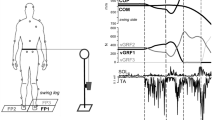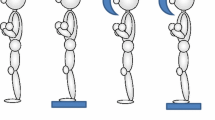Abstract
The aim of the study was to investigate the differences in anticipatory postural adjustments (APAs) between young and older adults and its effect on subsequent control of posture. Ten healthy older adults and thirteen healthy young adults were exposed to predictable external perturbations using the pendulum impact paradigm. Electromyographic activity of the trunk and leg muscles, the center of pressure (COP), and center of mass (COM) displacements in the anterior–posterior direction were recorded and analyzed during the anticipatory and compensatory postural adjustments (CPAs) phases of postural control. The effect of aging was seen as delayed anticipatory muscle activity and larger compensatory muscle responses in older adults as compared to young adults. Moreover, in spite of such larger reactive responses, older adults were still more unstable, exhibiting larger COP and COM peak displacements after the perturbation than young adults when exposed to similar postural disturbances. Nonetheless, while APAs are impaired in older adults, the ability to recruit muscles anticipatorily is largely preserved; however, due to their smaller magnitudes and delayed onsets, it is likely that their effectiveness in reducing the magnitude of CPAs is smaller. The outcome of the study lends support toward investigating the ways of improving anticipatory postural control in people with balance impairments due to aging or neurological disorders.





Similar content being viewed by others
References
Alexandrov AV, Frolov AA, Horak FB, Carlson-Kuhta P, Park S (2005) Feedback equilibrium control during human standing. Biol Cybern 93:309–322
Aruin AS, Latash ML (1995) The role of motor action in anticipatory postural adjustments studied with self-induced and externally triggered perturbations. Exp Brain Res 106:291–300
Aruin AS, Shiratori T, Latash ML (2001) The role of action in postural preparation for loading and unloading in standing subjects. Exp Brain Res 138:458–466
Basmajian JV, Blumenstein R (1980) Electrode placement in EMG biofeedback. Williams & Wilkins, Baltimore
Bazalgette D, Zattara M, Bathien N, Bouisset S, Rondot P (1987) Postural adjustments associated with rapid voluntary arm movements in patients with Parkinson’s disease. Adv Neurol 45:371–374
Belen’kii VE, Gurfinkel VS, Pal’tsev EI (1967) Control elements of voluntary movements. Biofizika 12:135–141
Bleuse S, Cassim F, Blatt JL, Labyt E, Derambure P, Guieu JD, Defebvre L (2006) Effect of age on anticipatory postural adjustments in unilateral arm movement. Gait Posture 24:203–210
Bouisset S, Zattara M (1987) Biomechanical study of the programming of anticipatory postural adjustments associated with voluntary movement. J Biomech 20:735–742
Dimitrova D, Horak FB, Nutt JG (2004) Postural muscle responses to multidirectional translations in patients with Parkinson’s disease. J Neurophysiol 91:489–501
Frank JS, Patla AE (2003) Balance and mobility challenges in older adults: implications for preserving community mobility. Am J Prev Med 25:157–163
Garland SJ, Stevenson TJ, Ivanova T (1997) Postural responses to unilateral arm perturbation in young, elderly, and hemiplegic subjects. Arch Phys Med Rehabil 78:1072–1077
Henry SM, Fung J, Horak FB (1998) EMG responses to maintain stance during multidirectional surface translations. J Neurophysiol 80:1939–1950
Hess JA, Woollacott MH, Shivitz N (2005) Ankle force and rate of force production increase following high intensity strength training in frail older adults. Aging Clin Exp Res 18:107–115
Horak FB, Nashner LM (1986) Central programming of postural movements: adaptation to altered support-surface configurations. J Neurophysiol 55:1369–1381
Inglin B, Woollacott M (1988) Age-related changes in anticipatory postural adjustments associated with arm movements. J Gerontol 43:M105–M113
Laessoe U, Voigt M (2008) Anticipatory postural control strategies related to predictive perturbations. Gait Posture 28:62–68
Li X, Aruin AS (2008) Anticipatory postural adjustments in conditions of simulated reduced gravity. Gait Posture 28:538–544
Man’kovskii NB, Mints A, Lysenyuk VP (1980) Regulation of the preparatory period for complex voluntary movement in old and extreme old age. Hum Physiol 6:46–50
Massion J (1992) Movement, posture and equilibrium: interaction and coordination. Prog Neurobiol 38:35–56
Mohapatra S, Aruin AS (2013) Static and dynamic visual cues in feed-forward postural control. Exp Brain Res 224:25–34
Mohapatra S, Krishnan V, Aruin AS (2012) The effect of decreased visual acuity on control of posture. Clin Neurophysiol 123:173–182
Nashner LM, Cordo PJ (1981) Relation of automatic postural responses and reaction-time voluntary movements of human leg muscles. Exp Brain Res 43:395–405
Park S, Horak FB, Kuo AD (2004) Postural feedback responses scale with biomechanical constraints in human standing. Exp Brain Res 154:417–427
Rogers MW, Kukulka CG, Soderberg GL (1992) Age-related changes in postural responses preceding rapid self-paced and reaction time arm movements. J Gerontol 47:M159–M165
Santos MJ, Aruin AS (2008) Role of lateral muscles and body orientation in feedforward postural control. Exp Brain Res 184:547–559
Santos MJ, Kanekar N, Aruin AS (2010a) The role of anticipatory postural adjustments in compensatory control of posture: 1. Electromyographic analysis. J Electromyogr Kinesiol 20:388–397
Santos MJ, Kanekar N, Aruin AS (2010b) The role of anticipatory postural adjustments in compensatory control of posture: 2. Biomechanical analysis. J Electromyogr Kinesiol 20:398–405
Shiratori T, Latash ML (2001) Anticipatory postural adjustments during load catching by standing subjects. Clin Neurophysiol 112:1250–1265
Skelton DA, Beyer N (2003) Exercise and injury prevention in older people. Scand J Med Sci Sports 13:77–85
Slobounov S, Hallett M, Stanhope S, Shibasaki H (2005) Role of cerebral cortex in human postural control: an EEG study. Clin Neurophysiol 116:315–323
Winter DA, Prince F, Frank JS, Powell C, Zabjek KF (1996) Unified theory regarding A/P and M/L balance in quiet stance. J Neurophysiol 75:2334–2343
Woollacott MH, Manchester DL (1993) Anticipatory postural adjustments in older adults: are changes in response characteristics due to changes in strategy? J Gerontol 48:M64–M70
Acknowledgments
This work was supported in part by the NIH grant # HD064838. We also thank Vennila Krishnan for help in data collection and Xiaoyan Li for assistance in data processing.
Author information
Authors and Affiliations
Corresponding author
Rights and permissions
About this article
Cite this article
Kanekar, N., Aruin, A.S. The effect of aging on anticipatory postural control. Exp Brain Res 232, 1127–1136 (2014). https://doi.org/10.1007/s00221-014-3822-3
Received:
Accepted:
Published:
Issue Date:
DOI: https://doi.org/10.1007/s00221-014-3822-3




